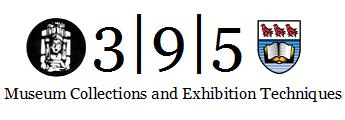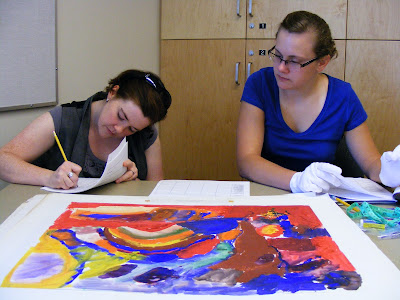

This blog is an interactive space for the documentation of anthropology 395, an intensive summer museum collection based field school at the University of Victoria. The course is centred around a recently acquired collection of aboriginal children's art by the Maltwood Art Gallery and Museum. Students' work to develop an exhibition of this artwork that will be shown at the Legacy Gallery in 2011 in downtown Victoria.
View the Complete Album!
Wednesday, July 21, 2010
Pitching Themes and Public Programming
 On Monday morning Cindy Vance from the Maltwood Gallery visited the students and spoke with them about public programming. After discussing some of the previous exhibits held at the Maltwood and Legacy Gallery and the public programming that accompanied them, students had the opportunity to brainstorm ideas and come up with their own ideas for public programming, entirely uninhibited by budget constraints!
On Monday morning Cindy Vance from the Maltwood Gallery visited the students and spoke with them about public programming. After discussing some of the previous exhibits held at the Maltwood and Legacy Gallery and the public programming that accompanied them, students had the opportunity to brainstorm ideas and come up with their own ideas for public programming, entirely uninhibited by budget constraints! This exercise was a prelude to the actual assignment of coming up with ideas for public programming for the exhibition of children's paintings. Today, Martin Segger, Caroline Riedel and Cindy Vance revisited the class to hear the presentation of their ideas.
Beginning with the tentative title, "Through the Eyes of Children: Art, Freedom, and Creativity", the primary theme of the proposed exhibition is Relationships. The theme of relationships is based around the idea of the reciprocity between Aller and the children he taught. The children's

art exists because of Aller, and Aller learned so much about the cultures and experiences of the children. Aller gave the children the opportunity to express themselves as they pleased, and the children painted and pasted their cultural knowledge and life experiences on paper.
The class shared two ideas for public programming. The first concept involved the creation of an interactive website that would act as (1) a database with photographs and information on all the art works in the collection (2) a forum for children to post their own art works online as a form of cross-cultural learning and sharing (3) a resource on Aller's teaching methods and philosophy and (4) a list of artists' names to enable easy searching by family members. In addition to this interactive space, workshops for children and talks by experts for adults about the collection were suggested.
The second idea for public programming was a story-telling and creative response session, where family members of Aller, the artists, and the artists themselves could come and talk to visitors to the exhibition about their experiences in relation to these art works. The audience would be given the opportunity to creatively respond to these stories, making this sort of programming family-friendly, educational, and an embodied, participatory experience.
Thursday, July 15, 2010
Setting the Stage

Today the class was honored to have Dr. Robert Dalton, of the University of Victoria's Art Education Program, visit and discuss children's art. From the perspective of an art educator, Dr. Dalton's lessons helped to place Aller's collection of children's paintings in the wider context of art education at the time these paintings were created. The role that teaching methods, curricula, and lesson plans might have played in the creation of the paintings has taken on greater significance in terms of understanding this collection, as well as in thinking about the themes that will shape the exhibition.
 Students have divided into groups to research and organize information that inform the exhibition of the art work. Some students envision the exhibition as a reflection of Aller's teaching methods and philosophies, hoping to actively immerse the audience in a context that reflects the time and space in which the art was created. Others hope that the exhibition will speak more directly about the children who created the art - a more daunting task due to the lack of information about these individuals. Regardless, sensitivity to and the communication of the historical context of these paintings has taken precedence at this stage of research.
Students have divided into groups to research and organize information that inform the exhibition of the art work. Some students envision the exhibition as a reflection of Aller's teaching methods and philosophies, hoping to actively immerse the audience in a context that reflects the time and space in which the art was created. Others hope that the exhibition will speak more directly about the children who created the art - a more daunting task due to the lack of information about these individuals. Regardless, sensitivity to and the communication of the historical context of these paintings has taken precedence at this stage of research.
Research into these matters has led the students to split up tasks: some listen to recorded interviews with Aller, organizing them by subject matter; some are reading through Aller's personal archives, containing notes, letters, and journal entires; and some have begun to sort through the vast collection of paintings to select which ones will be considered for the exhibition, careful to choose paintings from a variety of locations, age-groups, and painting styles and techniques.
Monday, July 12, 2010
Digging into the Archives

The beginning of the second week of classes and more matches have been made! The documenting and photographing of the works of art are wrapping up and students have begun to dig into the archival information. Newspaper clippings, letters, and other writings, along with the massive collection of photographs from Aller's archives hold a wealth of information that we hope will help to contextualize the children's paintings. Beyond that, what they have to say about Aller himself and his teaching methods and philosophies will be invaluable in the exhibition of the children's paintings.
Thursday, July 8, 2010
Lights and Cameras

Day three and the students have split tasks - some
continue work on organizing and documenting the collection, while others have begun creating the photographic record. After a crash course in
continue work on organizing and documenting the collection, while others have begun creating the photographic record. After a crash course in
photography from Julie Hulburt from the Maltwood Gallery, the students
were off to start photographing the children's

paintings! Documentation and photography continue over to day four...
Wednesday, July 7, 2010
Welcome to Anthropology 395!
The acquisition of a collection of Aboriginal children's art from across Canada by the Maltwood Art Gallery and Museum at the University of Victoria, coupled with the creative ingenuity of Dr. Andrea Walsh, in the Department of Anthropology, Caroline Riedel, Curator of Collections at the Maltwood, and Martin Segger, Director of the Maltwood Gallery, the hands-on field school Museum Collections and Exhibition Techniques was created. This course offers students the opportunity to build all sorts of museum-based skills while thoroughly engaged in the management, organization, and development of an actual exhibition.
Day one was an introduction to the course and the collection, of which 110 works of Aboriginal children's art are the central focus for the students. The collection exists because of an artist and art teacher, Robert Aller, who documented and collected these drawings from his art classes on reserves across Canada. Aller's work was certainly not limited to teaching children's art, though this element of his extensive résumé will be the focus of this class. Martin Segger joined us to talk a bit about Aller, who he knew as a personal acquaintance, to enlighten us on Aller's artistic philosophy, his teaching, and his personal and professional history.
Caroline Riedel joined us afterward to explain the tedious but necessary processes involved in organizing and documenting the entire collection, which the class jumped right into on the second day.


Day two, students are occupied with the children's drawings - filling out accession forms and condition reports for each work of art.
A disorganized box full of photographs were sorted through and those depicting the combination of a child (or children) with a work of art (or works of art) were pulled out and placed up on the wall. The goal is to try to match some of these paintings with the artists who created them, and try to contact them and their family members today.

A few matches were made - but the work of documentation and organization continues!
Subscribe to:
Posts (Atom)

